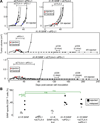Antigen-specific bacterial vaccine combined with anti-PD-L1 rescues dysfunctional endogenous T cells to reject long-established cancer
- PMID: 24455752
- PMCID: PMC3895468
- DOI: 10.1158/2326-6066.CIR-13-0058
Antigen-specific bacterial vaccine combined with anti-PD-L1 rescues dysfunctional endogenous T cells to reject long-established cancer
Abstract
Immunogenic tumors grow progressively even when heavily infiltrated by CD8(+) T cells. We investigated how to rescue CD8(+) T cell function in long-established immunogenic melanomas that contained a high percentage of endogenous PD-1(+) tumor-specific CD8(+) T cells that were dysfunctional. Treatment with αPD-L1 and αCTLA-4 blocking antibodies did not prevent tumors from progressing rapidly. We then tested exogenous tumor-specific antigen delivery into tumors using Salmonella Typhimurium A1-R to increase antigen levels and generate a proinflammatory tumor microenvironment. Antigen-producing A1-R rescued the endogenous tumor-specific CD8(+) T cell response: proliferation was induced in the lymphoid organs and effector function was recovered in the tumor. Treatment with antigen-producing A1-R led to improved mouse survival and resulted in 32% rejection of long-established immunogenic melanomas. Following treatment with antigen-producing A1-R, the majority of tumor-specific CD8(+) T cells still expressed a high level of PD-1 in the tumor. Combining antigen-producing A1-R with αPD-L1 blocking antibody enhanced the expansion of tumor-specific CD8(+) T cells and resulted in 80% tumor rejection. Collectively, these data demonstrate a powerful new therapeutic approach to rescue dysfunctional endogenous tumor-specific CD8(+) T cells and eradicate advanced immunogenic tumors.
Keywords: CD8+ T cell rescue; PD-L1; S. Typhimurium; Tumor rejection; vaccine.
Conflict of interest statement
Ming Zhao and AntiCancer, Inc. hold patents for tumor-targeting bacteria. All other authors declare no conflict of interest.
Figures





References
-
- Monach PA, Meredith SC, Siegel CT, Schreiber H. A unique tumor antigen produced by a single amino acid substitution. Immunity. 1995;2:45–59. - PubMed
-
- Wolfel T, Hauer M, Schneider J, Serrano M, Wolfel C, Klehmann-Hieb E, et al. A p16INK4a-insensitive CDK4 mutant targeted by cytolytic T lymphocytes in a human melanoma. Science. 1995;269:1281–1284. - PubMed
-
- Willimsky G, Blankenstein T. Sporadic immunogenic tumours avoid destruction by inducing T-cell tolerance. Nature. 2005;437:141–146. - PubMed
Publication types
MeSH terms
Substances
Grants and funding
LinkOut - more resources
Full Text Sources
Other Literature Sources
Research Materials

